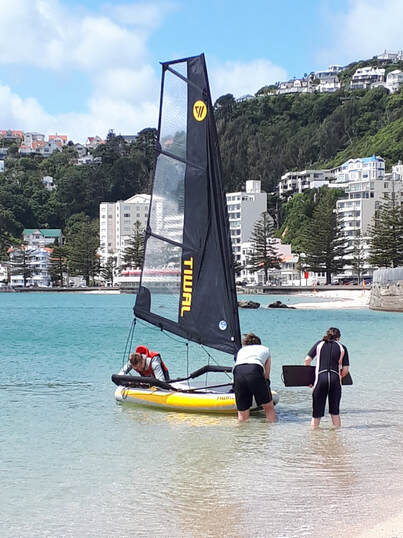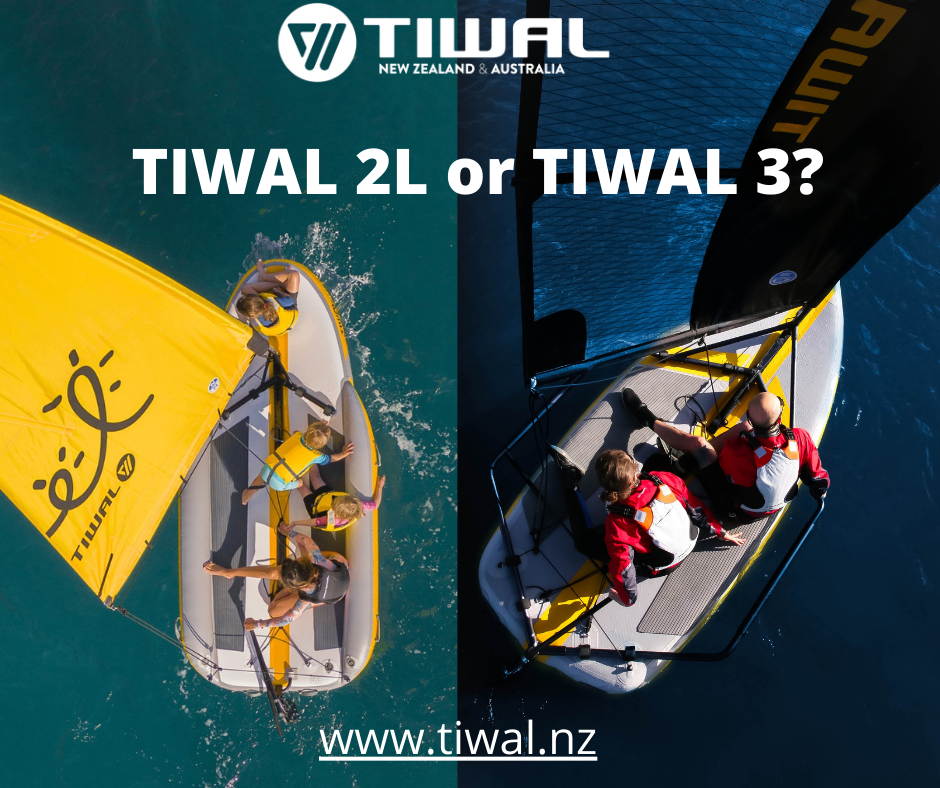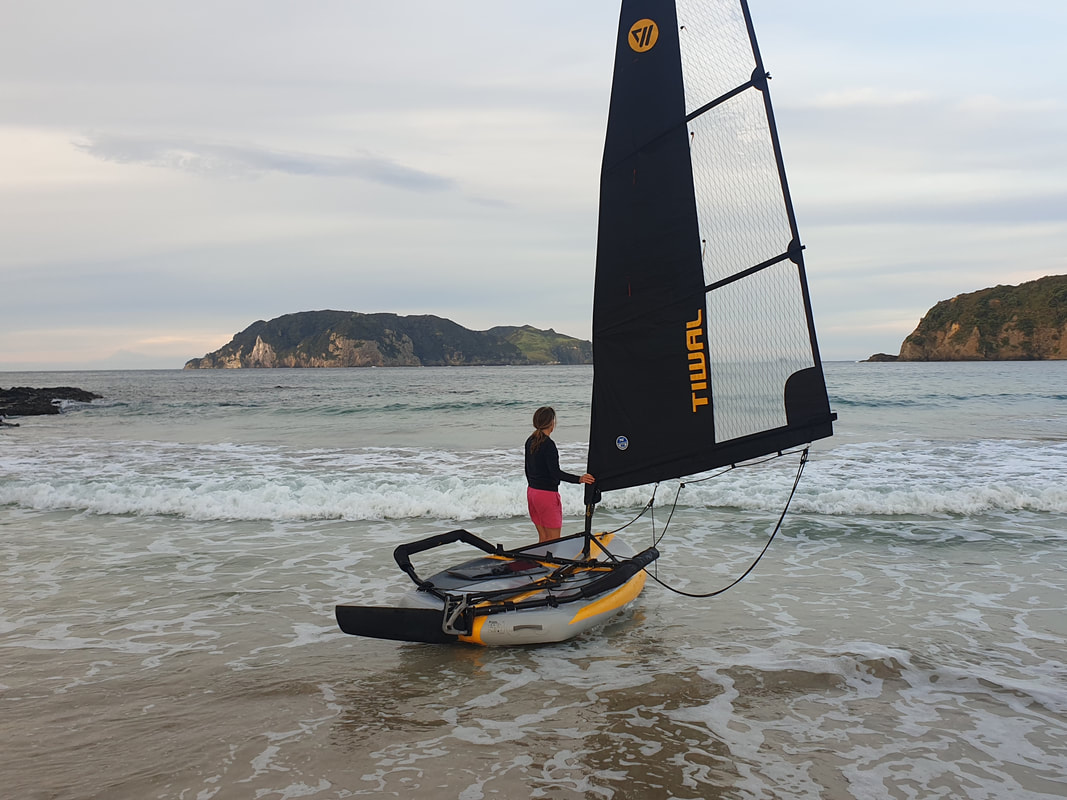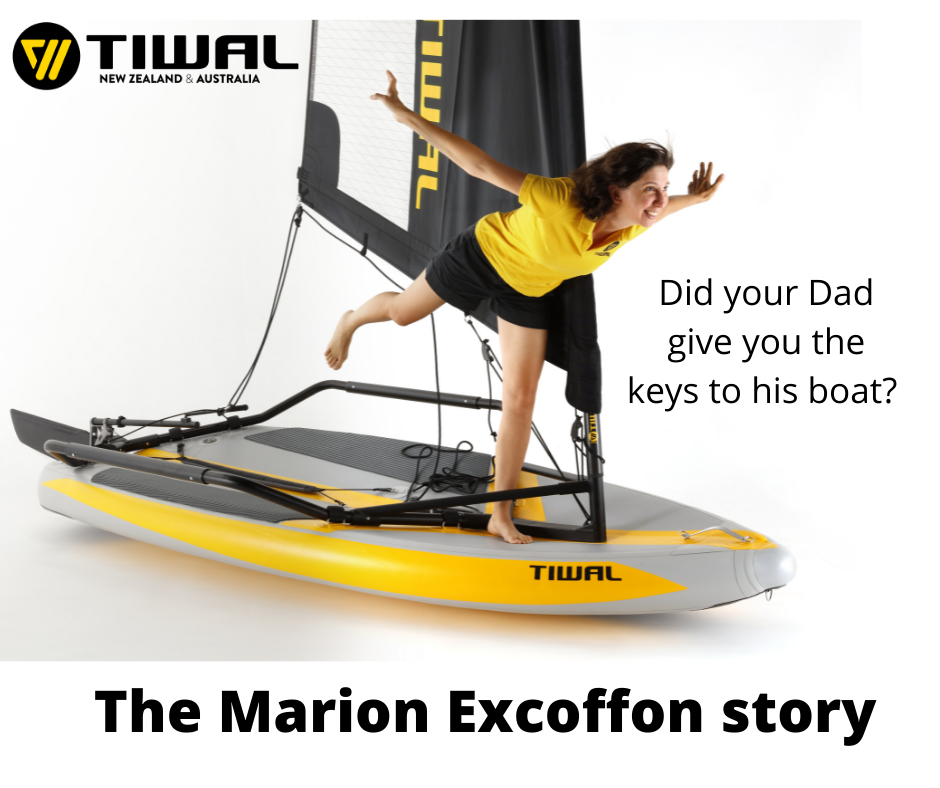|
Jo Aleh has had a break from Olympic sailing after winning two Olympic medals. She has been involved with coaching at Olympic level and worked as a corporate Performance Coach.
She has been through many challenges of being an athlete including pressures around looking athletic and focusing on her body weight. She says while on the surface she seemed to be performing well, she says not eating enough had a much higher consequence for her health in the long term. “Under-eating for three or four years and doing what I thought was healthy was actually very unhealthy.” She had constant stomach and sinus issues. “Three years after the Olympics I was still in a recovery phase, getting my body back to a state when I could actually do things again.” “I worry about the young girls come through there is an expectation to look athletic, and generally that is thin. When you are doing the amount of energy expenditure we do, you are better off not be really thin because then you have got no reserves. And you can’t be as strong and you can’t be as resilient.” There are many other more important things than your weight such as getting a good start or getting the first wind shift. As Jo returns to Olympic sailing she says “As long as I am enjoying my own sailing, I will take everything as it comes. I have realised I don’t always need a full plan. Things will pop up and if it seems like the right thing to do, then it is the right thing to do.” To find resources to help you encourage your children into good eating habits: www.emmawright.co.nz/ecourse For the full podcast listen here: https://www.facebook.com/YachtingNewZealand/videos/550576043161770 Author, Melinda Henshaw, is an ex Olympic sailor and is a member of NZ Marine Association and the Boating Industry Association of Australia and promotes the TIWAL Inflatable sailing dinghy for hassle free sailing. To find out about choosing your ideal sailboat, inspirational sailing stories and sailing tips, sign up here: https://landing.mailerlite.com/webforms/landing/m8v8v7
0 Comments
Is a new sailing dinghy for me or the kids/grandkids?
The answer is usually 'me'(!) and that is ok as the TIWAL 3 also has room for the kids or the grandkids when they are in town. The TIWAL 3 Inflatable maintenance free sailing dinghy can handle the breeze and the chop encountered in open water. The aluminium exoskeleton offers better stability when hiking out. In any wind above 13-15 knots of wind the T3 performs better. It is stiffer, faster and has better upwind speed, especially in choppy waters. The TIWAL 2 and 2L are simple inflatable sailing dinghies,quick to setup. Potter around in bays, anchorages, and lakes. The ideal training yacht for the kids and grandkids. The TIWAL 2 also fits in two bags, and has a quick assembly time of 15 minutes. Both sailing dinghies are award winning sailing dinghies. For help in choosing your ideal sailboat, TIWAL Tips, and inspirational stories get in touch with us by emailing [email protected]. Book a sail or contact us to find your local agent. The TIWAL is perfect for everyone in the family for hassle free sailing. Arriving at a beautiful place is a special feeling. We recently had a short break at Great Barrier Island - a large island off the coast of New Zealand. It had been a while since we had a holiday so it was all the more special to be there.
Great moments of our trip: -A friendly local on the ferry offering us his boat to fish from!!! -Watching Kaka (large native bird) eating the figs in the fig tree -Watching the Full moon at the beach -Freshly caught snapper off the rocks for breakfast -Eating strawberry guava off the hedge at the community garden -Collecting greenlip mussels at low tide (Friendly local, Peggy Garlick, from down the road turned up at the door WITH garlic for our mussel dish having heard we forgot to bring garlic with us!) - Hunting for Paua shells at Awana beach - Harataonga and the view to Arid Island - Sailing out to Arid Island in the TIWAL in a good swell. - The relaxing vibe at Okupu wharf and in the bay. - Sailing a TIWAL against the Lasers at a local sailing race at Tryphena - Having the TIWAL in the back so we could get on the water in 20 minutes with easy storage and setup. - Making an instructional video of the TIWAL gybing from an island cliff! The TIWAL Inflatable Sailing Dinghy is a great way to get back into sailing as you get all the great sensations of sailing a dinghy, but also the ease of boat handling on a comfortable boat with a high boom. And you get to go places! Take: A waterproof bag Manual pump Food and water Spare jacket Cellphone and waterproof case Check the weather and tide! Book a Sail at www.tiwal.nz "The Tiwal is just a nice way of gently snubbing my dad" says Marion Excoffon, TIWAL designer.
"I used to sail with my family on my father’s 30 foot sailboat ( a First 30 from Bénéteau) when I was a kid. When I turned about 20, I asked my father whether I could take it by myself. He refused. So I told him as a challenge: "Ok dad I will design and make my own boat by myself. Less than 2 years later (after many drawings, ideas and models), he was surprised to discover the first prototype of an inflatable boat (which would be named TIWAL few days later). As a designer, I didn't want to design 'just another boat' but a really new boat. Many sailing lovers dreamed about having their own sailboat, but that comes with many constraints. The TIWAL was born from a desire to make leisure sailing accessible to most sailors and to refocus on pure pleasure. My challenge was to design a sailboat that would be easily transportable, user-friendly, high performing and above all, a fun boat! Later, with the encouragement of my husband Emmanuel (who is also today my associate) we decided in 2012 to launched together a company to manufacture and distribute the Tiwal. Now 2200+ boats are already sailing in more than 45 countries worldwide and new Tiwal designs are born. It's an amazing story! And the happy end is that my father now lends me his boat! Thank you for all dad!" I have worked with a few coaches in my time. I have been coached by many amazing and giving people and some of these include Graham Mander, Hamish Willcox as a youth, by John Clinton, a technical expert, by the ‘The Medal Maker’, Victor Kovalenko, and many more. I remember learning from sailmakers, boatbuilders, riggers, sailors at the club and my peers.
When I think about coaching, some words that come to mind are supportive, consistent, available, approachable, communicative, knowledgeable, experienced and analytical. Most importantly, I have found that a great coach is a friend, even on your worst day. I have learned that at any level, in any field, you perform best when you are relaxed, confident and focused. A coach is a partner in your progress and your achievement. We often hear the word, facilitator. Meaning ‘to make easy’. You could describe a facilitator, as someone who makes learning easy, or focusing easy or whatever challenge you have, easier. A coach watches and helps you overcome your difficulties. If it didn’t happen today; the coach will be there tomorrow; and so will you be. No problem! "Great coaches have great experience, and great technical knowledge but they have rarely been the most outstanding performers themselves. Why? Well; often they are great team-members. They link well and make others look good. They know what it is like to have to find ways to improve regardless of natural ability and other difficulties. They become great analysts of the sport, and great communicators when coaching. Does this mean long speeches? No! But they can get through to you. They have special people skills" says Rob Dickson. When developing, failure is always on the pathway to success. A good coach creates an environment in which you can be relaxed and focused while you push your limits and develop your capacities. For that reason, even you could be your best coach to a point, if you have access to the right information - from reading, watching videos, and listening to the right people. You can push your limits to the point where you fail, but be kind to yourself and learn too! So now you have a boat (or do you?) are you going to get some guidance? How are you going to find someone to help you enjoy learning the basics? - Go to your local club and ask around - Advertise on local pages - Join local sailing pages - Ask a friend for recommendations - Ask people at your local beach/waterway - Ask other boat owners/previous owners To have someone to challenging you in a supportive way is a fantastic experience. So is having a coach who can share some special moments with you! To find out more about TIWAL Inflatable Sailing Dinghy packages including sailing lessons, email [email protected]. Just Unroll, Inflate and Sail Great! I read a book over lockdown called How to Get Strong. It is an old book, published in 1899 and written by William Blaikie.
Back in Blaikie's day, the number one public health enemy was consumption, an affliction of the lungs. So fresh air, deep breathing, and chest opening exercises were important. One concept of chest opening - opening the chest to give the internal organs more room, able to use more of your lungs and better for body alignment/posture. I wonder why when I was training as a fitness instructor (many years ago) I wasn't enlightened about some of the common sense of exercise? Or perhaps I wasn't ready to listen. It is so easy to fixate on getting individual leg or arm muscles working without taking account of the bigger picture. While yoga probably has done a lot to open and stretch the chest, it is nice to have a few exercises to do at home without investing in a yoga class. And although I would love a personal trainer, just a little common sense and a focus on health is enough motivate me to drag a friend down to the park with some dumbbells and a bit of knowledge. After six weeks of working on these exercises I feel my body working more in alignment and I will be so much more ready to take on more challenges that place more strain on my body. Get out on the water more easily and quickly this summer for some Vitamin Sea! Just 20 mins from Boot to Briny! Unpack 'n Sail the TIWAL Inflatable Sailing Dinghy - Unroll, Inflate and Sail Great! Best wishes Melinda The peak of my sailing career was at the 2000 Olympics. I was young 23yr old, and sailing in a 470, a two person boat. We had a top 10 world ranking, we were fully funded and we were ‘the cream of the cream’ the NZ Sports Foundation told us. Expectations were high. We were fast in the build up to the Games - we had a very well tuned, well built and fast boat. We had consistent, good results in the first few races of the regatta and our competitors took the chance to tack right on us when they could. Despite this, we were in 2nd place a few days into the regatta. There was nothing normal about this regatta; there were reporters surrounding the boat park, the regatta stretched to nine days long due to lay days and days with no wind. There was plenty of time for self doubt to creep in. We decided to use someone to spot the wind from the Sydney cliffs and talk to us via radio about the wind before the race. Perhaps we were overhyped and overthinking things, but I sailed the race looking around at everyone else instead of just focusing on our own race. We finished mid fleet. Then, I made a mistake during the rigging the next morning. We were doing well in the next race and then our jib falls down and we were sailing around the course with only one sail, helplessly watching our competitors sail away. After the race, we fixed our jib, but desperation took over and I thought I had to do something special. We crossed the start-line and hear the ‘individual recall’ hooter, but we couldnt bear to even consider we might have been over the start line too early, and we stubbornly don't look back. We raced hard and won but we didn't hear the gun when we cross the line - we were disqualified. I later heard we were not just a little bit over the line, we were well over. The team manager wanted to help give me a public profile and lead me to Peter Montgomery who is live on radio. Peter says, ‘Now Melinda, can you please explain to New Zealand how you can drop from 2nd place to 12th place in one day?’ On the last day of racing we had a beautiful breeze and the crowds were on Sydney’s cliffs cheering on the Aussie crew who were leading the regatta. My pride kicked in and I got caught up in the moment. We tacked in and out of the cliffs moving up the fleet, and I lean out (hike) a bit further, and a bit further still. Then during a tack, I missed my hiking strap and all of a sudden I am in the water staring at the underside of my capsized boat. Embarrassed at capsizing in front of cameras and crowds, we quickly righted the boat. We finished the regatta in 11th overall. Now, I can honestly say that the build up and the experience of being in Sydney for the Olympics was absolutely amazing. There was so much atmosphere and there were plenty of opportunities to distract myself from feeling the intense disappointment of our placing. And I still love sailing, which is why it is always a pleasure to get other people into sailing, especially in dinghies, with the TIWAL Inflatable Sailing Dinghy. When I'm not involved with TIWAL Inflatable Sailing Dinghies, I teach at Sailability and I have met so many interesting people and have learned so much from them.
Most of all, I like the people at Sailability. They make me feel so relaxed as they have so much understanding and endless amounts of patience. Some are anxious yet are not afraid to ask for help, and some have no fear at all, and will sail off into the horizon if I don't ask them to turn around. It reminds me to question my own self imposed 'rules' and self limiting beliefs. Lastly, I fully support the bid to get Paralympic Sailing back into the Paralympics. Let's get behind the bid! This is written by my partner who observed the scene at Sailability one day: What Sailing Can Teach Us by Robert L. Dickson Imagine this: You are one of a dozen 16 to 18 year-old youth at the yacht club's Youth Training Programme. You are being towed aboard a fleet of racing yachts to a pontoon where a hydraulic hoist will lift your boats from the water for maintenance. This fleet is to be used in a fast-approaching World Championships. You and your mates will be cleaning the slimy hulls of these yachts: a new experience for you all! As you approach the pontoon, you see a small fleet of colourful sailing dinghies tied along the pier. As you leap ashore, an old man on crutches shuffles awkwardly down the ramp towards you. Bert, who is ex-navy, has muscular dystrophy which limits his leg strength and control. He drops the crutches on the deck, and with the help of a younger fellow, begins to struggle into the closest sailing dinghy. You look at your friends for a reaction. They're looking at you for the same. The overhead boom and chain suddenly rattle and spring into action. You all look up to see another man in a sling being swung out over the water and lowered like a sack of spuds into a purple sailing dinghy a little further down the pier. John is almost quadriplegic since a hang-gliding accident 20 years ago. He smiles down and waves as you gaze in disbelief. With help, he is lowered into his seat, and begins to sort out ropes with fumbling hands. Just then, a wheelchair rolls down the ramp towards you. It's carrying a small woman (or is it a girl?) whose arms flail about wildly as her legs and feet twist and turn and her pretty face moves in all directions. 'Mack' has cerebral palsy. As you and your stunned friends watch in awe, she is lifted off the wharf and carefully manoeuvred down into the padded seat of a red-sailed dinghy in front of you. With her arms spread out strangely on the deck behind her like she’s flying, she quietly sails away from the dock, unassisted. A lady staggers onto the pontoon in a walking frame, dragging her feet awkwardly. Jan has progressing muscular dystrophy. With help, she leaves the frame, drops to her knees, and begins to crawl towards her yellow dinghy. She struggles aboard. Now, you and your friends begin to move to hold the boats while the rest of the Sailability squad get aboard. A young teenage boy with walking disabilities happily wanders past towards his yellow dinghy at the end of the pier. The coach, steps into a coach boat, starts the outboard, and follows her squad out into the harbour. You all watch silently until your supervisor calls you back to action. It's scrubbing time! A week later on the squadron's pontoon, your coach announces that he’s invited a motivational speaker to talk to you this morning about ‘attitude’. The speaker will arrive soon. You are all hoping the coach has secured an America's cup skipper, or one of the many Olympians. Flailing her arms, feet and head as she’s wheeled towards you is ‘Mack’, the cerebral palsy girl. Mackenzie Kench is your motivational speaker on ‘attitude’. She will address you through an electronic dictaphone. You know now that you will never forget this day, this girl, and the lesson you’re learning on attitudes to life, living and humanity: lessons about humility, patience, determination and the realities of life outside your comfort zone. Way outside! The Sailability Experience. Any contact with 'Sailability' is a collision with your own attitude. It's a privilege for that reason. Sailability is not about boats or about sailing. It's about people who won't submit to circumstances, and about helping others to do the same. The closer you get, the more you realise 'Together Everyone Achieves More'. TEAM. It might be a team of just two; but it takes a team! A carer or coach and a keen learner. A boat rigger or trailer repairer and a keen sailor. A boom winch operator and a paraplegic adventurer. A yachtsman or ferry-driver on the harbour, and a cerebral palsied girl in a colourful little sailboat. If you 'get' the team thing here, you are about to have a life-changing experience. The Sailability Experience is repeated many times weekly around the world. You see fear, pain, ignorance, limitations and 'inabilities' overcome; freedom and joy achieved against all odds; and courage, freedom and optimism demonstrated. Out on the water in colourful little boats, with ferries tooting, and motor launches, yachts and speedboats swerving and waving, very few people have any idea what they are witnessing! On any day here, if you know what you’re seeing, you’ll get a healthy re-set of your attitudes, and a reminder of what is important in life. Best wishes Melinda PS To get in touch with a TIWAL Agent near you, send me an email [email protected] and we will book a sail with a TIWAL sailboat, for hassle free, low maintenance sailing. How to get on the water in 20 minutes!
So which TIWAL Inflatable Sailing Dinghy Sail do you choose and is there really much difference? Some questions to ask yourself: How heavy am I or and how much sail area do I need? What about family? Or How experienced am I and how much sail do I need? If a TIWAL 2 is for taking on another bigger boat, what size boat do you have and will it be simpler and easier to use a sail without many battens? Here are some answers which I hope will make your decision easier: Will the buckles on the Reefable Sail affect airflow? Sailing Dinghies sail close to the water and there is less wind down low due to a 'surface layer' of lighter wind. So the bottom section of the sail isn't having a huge impact on your speed. The top part of the sail is what matters. So will the boat still sail optimally? The answer is yes. The buckles will have a minimal effect on the speed of your boat. Will a battened sail 'hold its shape' for longer? A full battened sail will 'hold its shape' longer than a sail without many battens. Will a sail made with monofilm (see-through material) last as long as a Daron sail? A sail with monofilm will last well, as long as the sail isn't folded along the monofilm. The TIWAL sails are designed to fold along the black Dacron. What is the benefit of the Furling Sail on the TIWAL 2? A sail without many battens is easier to rig, handle, and stow on a smaller boat where having less room to move is an issue. The furling sail also wraps around the mast by removing the boom and undoing the vang and the traveller. The sail wraps around the mast and is held in place using the velcro strip on the sail. This is good for leaving the TIWAL 2 tied off the back of the boat when you are not using it. Do you want the option of having two sail sizes in one sail? If you have multiple sailing abilities or sizes of people in your family then the Reefable sail is a good option for you! TIWAL 3: Do you have the room to keep two sails rigged to grab whichever one you need on the day for hassle free sailing? If the answer if yes, purchase both the big and small sails and keep them rigged and ready to put straight on the mast and ready to go!  Hello TIWAL owners, I am in lockdown in Auckland, so I join the majority of you also in some sort of lockdown. I spoke too soon. So, in the spirit of feeling useful, enlightened, and part of the TIWAL community, read on. When I tried a small foiling boat for the first time I did more swimming than sailing. I thought I was a good sailor! I needed to get back to basics again - and learn more about apparent wind. Maybe it will help me with my other sailing too? Have you ever struggled to get sailing? Here is an explanation of apparent wind and why you need to know about it. Apparent wind is the wind we feel and experience when we are in motion. It's a combination of the actual wind (true wind) that blows over land and sea and the wind created by our moving forward. Think of your bike when it is moving fast. That wind you feel on your face is apparent wind. Even if there is a slight wind at your back (the true wind) you can still feel the wind coming from in front of you (the apparent wind). Now, increase that following wind and, at the same time your bike speed, you'll start feeling less of a headwind coming at you. That's because apparent wind is a combination of the true wind and the wind created by speeding forward. The important thing to realize here, however, is that as you travel faster the apparent wind not only increases in speed but it also changes the angle of the wind. Now relate that to sailing: the wind we feel on our face as we are sailing is the same wind the sail feels - we sail to the apparent wind, not to the true wind. Have you ever struggled to get moving in very light winds? Try these two things: 1. Adjust your steering to sail at a reaching angle (across the wind) to increase your boat speed. Once you have increased your boat speed you can then point higher into the wind. You will also be able to steer more easily with more water flow over your centreboard and rudder. 2. The wind hits the sail at a different angle up high, and that means you adjust your sail accordingly - ease the mainsheet to ’twist’ the sail at the top. When there is almost no wind, the layer of air close to the water is very slow. The wind higher up maybe 2 knots more. So you may have 0.5 knots at the bottom of your sail and 2.5 knots at the top of your sail. Slow wind speeds on the surface mean if you are sailing upwind, beam reaching or broad-reaching it will mean that the apparent wind will be almost directly ahead of you at your eye level, but at the top of the mast the wind will be coming more from the side so there will be a massive twist (change of direction in the apparent wind). If you want to enjoy a smooth sailing experience or an adrenaline filled ride, book a sail in a TIWAL Inflatable Sailing Dinghy and get on the water in 20 minutes. |
Melinda HenshawI am a New Zealand sailor who learned to sail in the beautiful Malborough Sounds and then went onto represent NZ at the 2000 Olympics. Archives
December 2023
Categories |






 RSS Feed
RSS Feed
